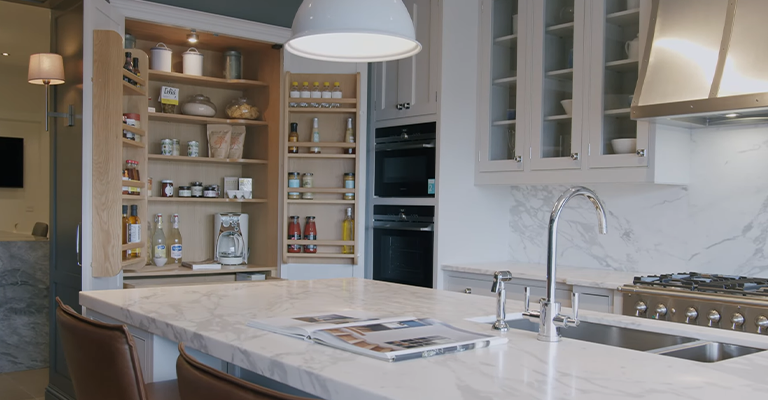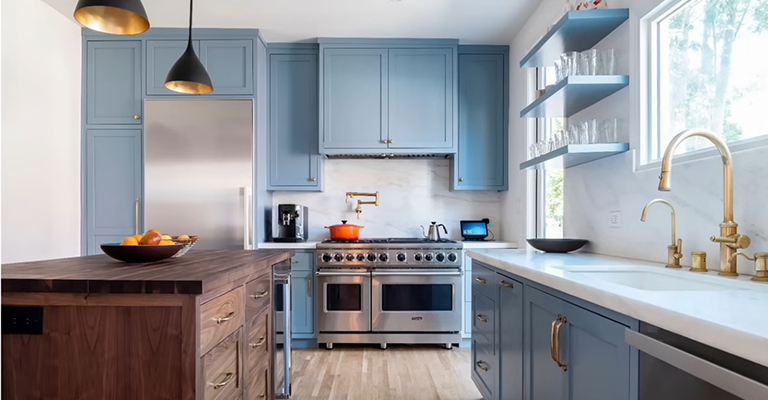Why Is My Charcoal Grill Not Getting Hot?-Troubleshooting Guide
When it comes to outdoor cooking, a charcoal grill is a beloved companion for many, offering a unique flavor and experience.
However, there are times when this trusty culinary partner might not perform as expected, leaving you wondering why it’s not reaching the desired high temperatures for that perfect sear or that slow and steady smoking session.
The reasons behind a charcoal grill not getting hot can be multifaceted, and understanding them is crucial for grill enthusiasts.
In this guide, we’ll explore the common factors that can hinder the performance of your charcoal grill, and we’ll provide insights and solutions to help you troubleshoot and reignite your grilling passion.
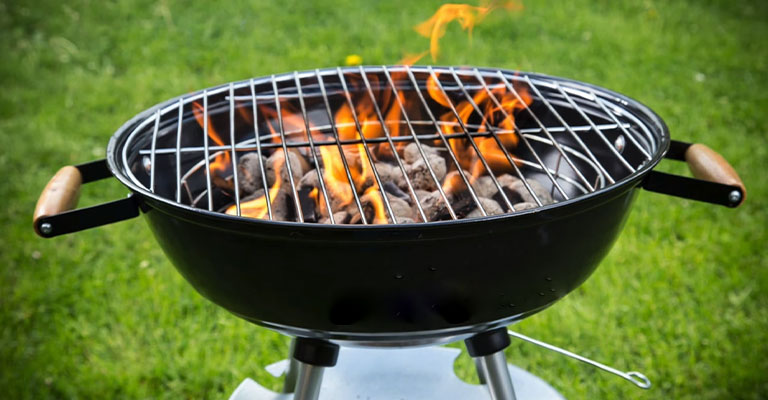
What Is a Charcoal Grill?
A charcoal grill is a cooking appliance designed for outdoor use that uses charcoal briquettes or lump charcoal as the primary fuel source. It typically consists of a metal or ceramic body with a cooking grate, a charcoal grate, and vents for controlling airflow.
To cook, charcoal is ignited, and when it reaches the desired temperature, food is placed on the cooking grate. The coals generate intense, smoky heat, infusing food with a unique flavor.
Charcoal grills are favored for their portability, affordability, and the unmistakable taste they impart to grilled dishes, making them a popular choice for backyard barbecues and outdoor cooking enthusiasts.
Why Is My Charcoal Grill Not Getting Hot?
A charcoal grill not reaching the desired temperature can be frustrating, especially when you’re looking forward to a delicious barbecue.
There are several reasons why this might happen, and it’s important to troubleshoot to get your grill back in working order.
Here are some common reasons why your charcoal grill may not be getting hot:
Insufficient Airflow
Proper airflow is vital for a charcoal grill to function optimally. The grill has vents, usually at the bottom and the top, that regulate the flow of oxygen.
When these vents are clogged with ash or debris, or not opened wide enough, it restricts the inflow of oxygen necessary for combustion. Regularly check and clean these vents to ensure they’re unobstructed.
Improper Charcoal Arrangement
How you arrange the charcoal can greatly influence its performance. If the coals are densely packed, air struggles to circulate, leading to inefficient combustion. Conversely, if they’re spread too thin, they might not generate enough heat.
The two-zone fire method, where coals are arranged on one side for direct heat and the other side is left empty for indirect heat, can help manage heat levels effectively.
Damp or Wet Charcoal
Charcoal should be stored in a dry place, as moisture hinders ignition. Wet charcoal will take longer to reach high temperatures and may not burn evenly.
Consider investing in an airtight container or storing charcoal in a dry shed or garage to prevent it from absorbing moisture.
Low-Quality Charcoal
The quality of charcoal can vary widely. Cheaper or inferior-quality charcoal may contain more fillers or have inconsistent sizes, which can impact how it burns. Opt for reputable brands or consider using natural hardwood charcoal for better results.
Inadequate Preheating Time
Rushing the preheating process can lead to uneven heat distribution. Allow the charcoal to burn until a layer of white ash forms on the coals.
This indicates that they are at their hottest and most stable temperature. It typically takes about 15-30 minutes after lighting for the coals to reach this stage.
Damaged or Clogged Vents
Inspect the vents for any obstructions, rust, or damage. If the vents are not functioning properly, it can hinder airflow, leading to suboptimal combustion.
Regular maintenance, including cleaning and occasionally lubricating the vents, can ensure they operate smoothly.
Wind or Cold Weather
Environmental conditions can play a significant role in a charcoal grill’s performance. Windy conditions can blow away heat, making it harder for the grill to maintain a consistent temperature.
In cold weather, it takes longer for the coals to reach the desired temperature. Consider using a windbreak or placing the grill in a sheltered area to mitigate these effects.
Old or Stale Charcoal
Charcoal can deteriorate over time, losing some of its effectiveness.
When your charcoal has been stored for an extended period, it might not perform as well as fresh charcoal. Consider using newer charcoal for better results.
Inadequate Lighting
The method you use to light the charcoal can impact how well it burns. Chimney starters or electric starters provide a more controlled and efficient ignition compared to lighter fluid, which can sometimes leave residues that inhibit proper combustion.
Grill Size and Design
Different grills have varying designs and sizes, which can affect their heating capabilities. Larger grills may require more charcoal to reach and maintain high temperatures.
Additionally, certain grill designs may distribute heat unevenly, so it’s important to be aware of your specific grill’s characteristics.
Improper Lid Usage
Closing the lid of your grill helps trap heat and ensures even cooking. If the lid isn’t used correctly or is damaged, it can lead to inefficient heating.
Always make sure the lid fits securely and is in good condition to maximize heat retention.
Common Mistakes and How to Avoid Them
Grilling over charcoal can result in some of the most flavorful and satisfying meals. However, there are common mistakes that even experienced grillers can make.
Understanding these pitfalls and knowing how to avoid them can make a significant difference in the outcome of your grilling sessions.
Here are some key errors and the steps to take to ensure your charcoal grill experience is a success:
Using Too Much Charcoal
- Mistake: Overloading the grill with charcoal can lead to excessively high temperatures that are difficult to control.
- Avoidance: Use the appropriate amount of charcoal for the type of grill you have and the amount of food you plan to cook. Follow the manufacturer’s guidelines for recommended charcoal quantities.
Neglecting Airflow
- Mistake: Failing to manage airflow through the grill vents can result in uneven cooking and trouble maintaining consistent temperatures.
- Avoidance: Regularly clean the vents and adjust them as needed during cooking. Ensure they are free from obstructions to allow proper airflow to the charcoal.
Ignoring Preheating
- Mistake: Rushing the preheating process can lead to unevenly heated grates and difficulty in achieving the desired cooking temperature.
- Avoidance: Allow ample time for the charcoal to heat up. It typically takes about 15-30 minutes after lighting for the coals to reach the optimal cooking temperature.
Using Lighter Fluid Improperly
- Mistake: Applying too much lighter fluid or not allowing it to burn off completely can result in a chemical taste in the food.
- Avoidance: Use a chimney starter or electric starter for a more controlled ignition. If using lighter fluid, apply it sparingly and allow it to burn off completely before placing food on the grill.
Opening the Lid Too Often
- Mistake: Frequently lifting the lid allows heat to escape and can extend cooking times.
- Avoidance: Keep the lid closed as much as possible. Use the vents to regulate temperature and only open the lid when necessary to check or flip the food.
Forgetting to Clean the Grill Grates
- Mistake: Neglecting to clean the grates can lead to sticking and uneven cooking.
- Avoidance: Preheat the grill and use a grill brush to thoroughly clean the grates before and after each use. This also helps prevent flavors from past cooking from transferring to your current meal.
Not Letting Meat Rest
- Mistake: Cutting into meat immediately after grilling can lead to juices spilling out, resulting in drier meat.
- Avoidance: Allow grilled meat to rest for a few minutes before serving. This allows the juices to redistribute, resulting in juicier, more flavorful meat.
Using Low-Quality Charcoal
- Mistake: Inexpensive or low-quality charcoal can contain fillers or burn inconsistently, affecting the grilling experience.
- Avoidance: Invest in good-quality charcoal, preferably natural hardwood charcoal, for better heat consistency and flavor.
Overcomplicating Seasoning
- Mistake: Using too many seasonings or marinades can overpower the natural flavors of the food.
- Avoidance: Keep it simple. Use a light rub, some salt, and perhaps a touch of olive oil to let the natural flavors of the ingredients shine.
Not Having Essential Grilling Tools
- Mistake: Being unprepared without the necessary tools can lead to frustration and difficulty in managing the grill.
- Avoidance: Ensure you have essential tools like tongs, a meat thermometer, grill gloves, and a basting brush on hand before you start grilling.
Maintaining and Cleaning Your Charcoal Grill
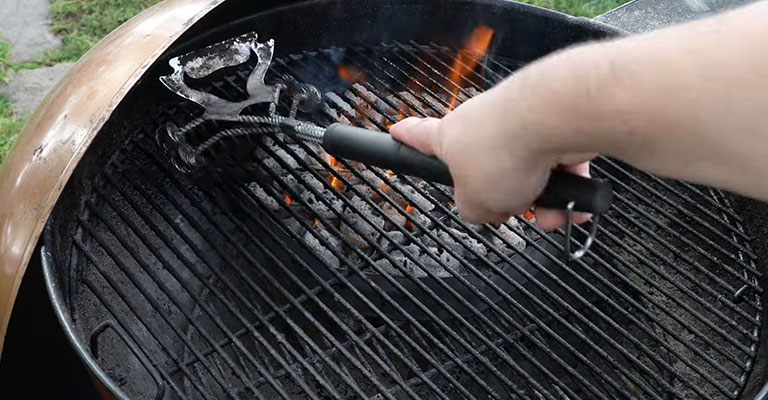
Maintaining and cleaning your charcoal grill is essential for ensuring its longevity and optimal performance. Regular upkeep not only extends the life of your grill but also contributes to better-tasting food and a safer grilling experience.
Here’s a comprehensive guide on how to properly maintain and clean your charcoal grill:
Tools and Materials:
Maintenance:
- Grill brush or scraper
- Wire brush or steel wool
- Grill covers
- High-temperature oil or spray
- Replacement parts
Cleaning:
- Mild dish soap or grill cleaner
- Warm water
- Bucket or basin
- Grill brush or scraper
- Aluminum foil or disposable drip pans
- Soft cloths or paper towels
Regular Grate Cleaning
- Maintenance: After each use, use a grill brush to scrub the grates. For tougher residue, use a scraper or wire brush. Apply a thin coat of high-temperature oil on the grates to prevent rusting.
- Cleaning: For a deeper clean, remove the grates and soak them in warm, soapy water. Scrub with a brush or steel wool, then rinse thoroughly and dry before reattaching.
Emptying Ashes
- Maintenance: Empty the ash catcher or tray after each use to prevent ash buildup, which can hinder airflow.
- Cleaning: Wear gloves and use a metal scoop or ash tool to remove ashes. Dispose of them in a non-combustible container.
Cleaning the Lid and Bowl
- Maintenance: Wipe the inside of the lid and bowl with a grill brush or scraper after each use. This prevents the accumulation of grease and soot.
- Cleaning: For a thorough clean, mix warm soapy water and use a soft cloth or sponge to wipe down the interior and exterior. Rinse with clean water and dry thoroughly.
Checking and Replacing Parts
- Maintenance: Regularly inspect the grill’s components, such as vents, handles, and wheels, for any signs of wear or damage.
- Cleaning: Clean and lubricate hinges, handles, and any moving parts with a food-safe lubricant to prevent rust and ensure smooth operation.
Inspecting and Replacing Charcoal Grate
- Maintenance: Check the charcoal grate for signs of wear or deterioration. Replace if necessary.
- Cleaning: Remove any ash or debris from the charcoal grate after each use.
Grease Management
- Maintenance: Use drip pans or aluminum foil to catch grease and prevent flare-ups.
- Cleaning: Empty and replace drip pans or foil regularly to avoid excessive grease buildup.
Storing Your Grill
- Maintenance: When your grill is not in use for an extended period, consider using a grill cover to protect it from the elements.
- Cleaning: Ensure the grill is completely clean and dry before covering it. Store it in a dry, sheltered area away from direct exposure to rain or extreme weather conditions.
Tips for Identifying and Fixing Specific Issues
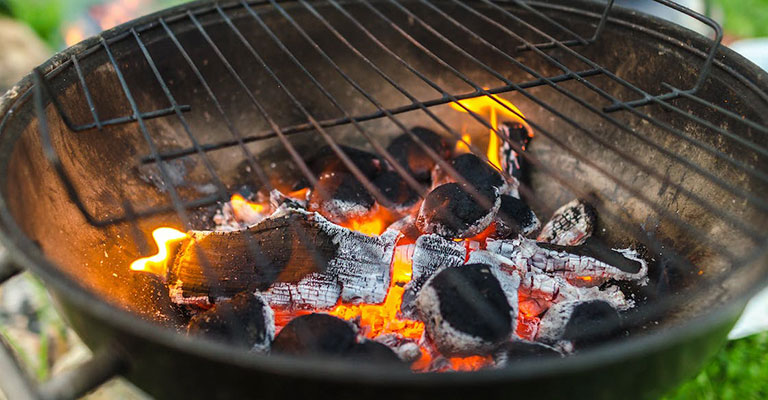
Identifying and addressing specific issues with your charcoal grill is essential for maintaining optimal performance.
Whether you’re dealing with uneven heat distribution, ignition problems, or other common grill-related challenges, understanding how to diagnose and fix these issues will ensure you get the most out of your grilling experience.
Here are some tips for identifying and fixing specific issues with your charcoal grill:
Uneven Heat Distribution
- Identification: When you notice that one area of the grill is significantly hotter than another, it’s a sign of uneven heat distribution.
- Fix: Rearrange the charcoal to create a two-zone fire. Place the coals on one side for direct heat and leave the other side empty for indirect heat.
Difficulty in Lighting Charcoal
- Identification: When the charcoal is struggling to ignite or takes an unusually long time to light, it indicates a problem with the ignition process.
- Fix: Ensure you’re using a reliable method to light the charcoal, such as a chimney starter or electric starter.
Excessive Smoke
- Identification: When your grill is producing an excessive amount of smoke, it can be due to several factors, including damp charcoal, poor airflow, or greasy grates.
- Fix: Use dry, high-quality charcoal and store it in a dry place to prevent moisture absorption. Clean the grates regularly to remove excess grease.
Difficulty Controlling Temperature
- Identification: When you’re struggling to maintain a steady temperature, it’s likely due to airflow issues or improper charcoal arrangement.
- Fix: Check the vents to ensure they’re open and functioning properly. Adjust them as needed to regulate airflow. Arrange the charcoal for a two-zone fire, and use the vents to fine-tune the temperature.
Rust and Corrosion
- Identification: Rust spots or corrosion on the grill’s exterior or components can be unsightly and may lead to structural damage if not addressed.
- Fix: Regularly clean and dry the grill after each use. Apply a high-temperature paint or coating to any areas showing signs of rust.
Uneven Cooking Results
- Identification: When some parts of the food are overcooked while others are undercooked, it indicates uneven heat distribution.
- Fix: Use a two-zone fire method and rotate or move the food as needed during cooking.
Damaged or Stuck Vents
- Identification: When the vents are damaged or difficult to move, it can hinder airflow and temperature control.
- Fix: Clean the vents regularly to prevent obstructions. If the vents are stuck or damaged, consider replacing them with compatible parts.
Faded or Worn Exterior
- Identification: Over time, the exterior of the grill may become faded or worn due to exposure to the elements.
- Fix: Use a grill-specific cleaner to remove dirt and grime. Apply a high-temperature paint or finish to restore the grill’s appearance.
FAQs
What can I do if my charcoal grill is not getting hot enough?
You can check if the vents are open and unobstructed, rearrange the charcoal for better airflow, and allow sufficient preheating time.
Do damp coals affect the grill’s temperature?
Yes, damp or wet charcoal can lead to lower temperatures and difficulty in achieving desired heat levels.
Can using low-quality charcoal be a reason for inadequate heat?
Yes, low-quality charcoal with inconsistent sizes or excessive fillers may hinder the grill’s ability to reach and maintain high temperatures.
Is it possible for a damaged vent to be the cause of low heat in my grill?
Yes, damaged or clogged vents can restrict airflow, leading to insufficient combustion and lower temperatures.
What should I check if my charcoal grill is not getting hot even after using a chimney starter?
Ensure that the vents are open and clean and that the charcoal is arranged properly.
To Recap
Several factors can contribute to a charcoal grill not reaching desired temperatures. From inadequate airflow due to clogged vents to damp or low-quality charcoal, each issue demands specific attention.
Proper maintenance, such as regular cleaning and using quality charcoal, is paramount. Additionally, mastering techniques like arranging coals for efficient combustion and allowing ample preheating time can make a significant difference.
Understanding these potential pitfalls empowers grill enthusiasts to troubleshoot effectively, ensuring that their charcoal grill operates at its optimal capacity, delivering mouthwatering, perfectly cooked dishes every time.
With care and attention, a charcoal grill can continue to provide memorable outdoor cooking experiences for years to come.
